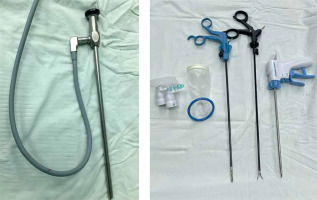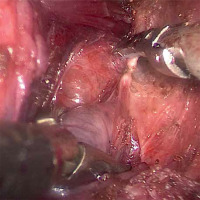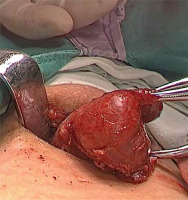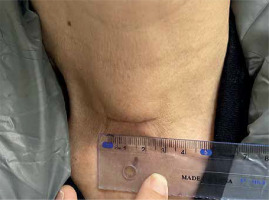Introduction
Conventional open thyroidectomy (COT) has been the most common approach for thyroidectomy, with a long incision in the neck, a portion of the body prominently exposed. Since the morbidity of thyroidectomy has decreased to a minimum, cosmetic outcomes have become progressively important, motivating surgeons to develop alternative approaches. These alternative approaches evolved along 2 paths: remote-access and minimally invasive techniques [1]. Remote-access thyroidectomy moves the incision from the visible anterior neck to a more hidden location to obtain an excellent cosmetic outcome at the cost of more extensive subcutaneous dissection, longer operative time, a steeper learning curve and even more complications [1–4]. The transoral endoscopic thyroidectomy vestibular approach (TOETVA) represents the latest remote-access endoscopic technique for thyroidectomy. There is less tissue dissection and distance to reach the thyroid, and there is complete avoidance of a skin scar with incisions hidden in the vestibular mucosa. However, the prolonged operation time compared to COT is a limitation which prevents it from being widely used. Minimally invasive procedures including minimally invasive nonendoscopic thyroidectomy (MINET) and minimally invasive video-assisted thyroidectomy (MIVAT) employ an anterior cervical incision but significantly reduce the length. Both MINET and MIVAT have been demonstrated to have less postoperative pain and better cosmetic results in selected cases in comparison with COT [5–8]. However, both of them have some distinct drawbacks. MINET is a thyroidectomy performed without an endoscope using an incision of no more than 3.5 cm [5, 6]. It has deficiencies of a narrow operative window and difficult dissection of the recurrent laryngeal nerve owing to a limited visual view [9, 10]. MIVAT with mechanical retraction pioneered by Miccoli was initially done with an incision of about 1.5 cm [11]. Some experts changed the incision length (increased to 2.0–3.5 cm) to include more patients eligible for this technique [12, 13]. Drawbacks of the MIVAT technique include cumbersome operation of the endoscope and other instruments in a tiny incision and narrow working space without fulcrums [14, 15], and the challenge to maintain a steady screen image [16, 17]. The operation time is usually obviously longer than that of COT [7, 8].
In February 2021, we designed a hybrid technique for thyroidectomy, minimal transcervical access single-port endoscopy-assisted thyroidectomy (Huang’s procedure – HP), which combines the advantages of single-port endoscopic surgery with carbon dioxide insufflation and mini-incision open thyroidectomy. The initial results are encouraging.
Aim
The purpose of this study was to illustrate the technique of HP, assess the safety and clinical efficacy of this technique and compare the results with those achieved by COT.
Material and methods
Patients selection and study design
This is a retrospective comparative study from a prospectively maintained database of thyroidectomy between February 2021 and February 2022. Thirty patients who underwent HP (HP group) and 18 patients who underwent COT (COT group) were included in this study. The inclusion criteria were as follows: (1) patients were pathologically confirmed to have benign thyroid nodules; (2) the nodules were limited to one lobe; (3) maximal nodule diameter ≤ 4 cm as estimated by preoperative ultrasound; and (4) patients were symptomatic or worried that the nodules may continue to grow or become malignant and actively requested surgery. The patients with the following conditions were excluded: (1) diagnosis of malignancy at intraoperative frozen section or final pathology; (2) thyroid volume > 40 ml as estimated by ultrasound; (3) substernal goiter; (4) hypervascular thyroid; (5) prior thyroid surgery; (6) a certain degree of dysfunction in their hearts, lungs, livers or kidneys. All patients were informed about the character of both COT and HP before surgery. The choice of surgical approach was based on the patient’s preference. All patients provided their written informed consent. All patients underwent a lobectomy and all operations were completed by the same primary surgeon. This study was approved by the Institutional Ethics Committee.
Operative technique of HP
Operative instruments
In addition to the same instruments as those for COT, the following tools are necessary in HP: a 5- or 10-mm 30-degree laparoscope with a right-angle light cable connector, a single multi-channel port, and working instruments (laparoscopic grasper, Maryland dissector and 5 mm harmonic scalpel) of different lengths utilized to avoid hand clashing (Photo 1). The single multi-channel port (Surgaid Co., Ltd., Xiamen, China) used by us is composed of a wound retractor component and a valve component. The retractor component consists of one internal retraction ring, one external retraction ring and a retractable plastic sleeve connecting the two rings. The valve component made of a special elastomeric material has three valve channels for laparoscopy and working instruments insertion, in addition to two insufflation/venting valves for gas insufflation and smoke evacuation.
Patient positioning and operating room setup
Under general endotracheal anesthesia, the patient is placed in the supine position, and the neck is mildly extended with the arms tucked at the sides. The primary surgeon stands opposite to the side of the lesion. An assistant holding the camera stands on the contralateral side of the primary surgeon. The monitor is positioned at the head side of the patient.
Surgical steps
In brief, HP is conducted with the following three sequential components: (1) Skin incision and creation of a working space for single-port endoscopic surgery (performed under direct vision); (2) dissection of the superior pedicle and inferior pole, and identification of the recurrent laryngeal nerve and the parathyroid glands (performed under single-port endoscopy); (3) extraction and resection of the thyroid lobe, and incision closure (performed under direct vision).
An initial 2.5 cm collar incision is made about 2 fingers above the suprasternal notch. The incision may be extended to up to 3.0 cm later if necessary. A natural deep skin crease is preferable if present. The platysma is divided. The subplatysmal space is developed to the thyroid cartilage superiorly and the suprasternal notch inferiorly. The cervical linea alba is divided longitudinally. The strap muscles are separated from the thyroid lobe. The isthmus is divided and dissected off the trachea. A working space for single-port endoscopic surgery is constructed just under the platysma muscle or strap muscles. The method to construct the working space under the platysma is as follows: Two or 3 percutaneous stay sutures penetrating the strap muscles are placed for retracting the strap muscles laterally to expose the thyroid. The internal anchoring ring of the retractor component of the single multi-channel port is inserted into the operative site under the platysma. One should carefully check to ensure that no tissue entrapment has occurred. The external retraction ring is gently grasped and pulled up until the internal anchoring ring sits tightly against the platysma. The external ring is flipped inward until desired retraction is achieved, then the valve component of the single multi-channel port is connected with the external ring (Photo 2). The working space is maintained with low pressure carbon dioxide insufflation at 4–6 mm Hg and flow rate of 6 l/min. The method to construct the working space under the strap muscles is similar to that under the platysma; however, the percutaneous stay sutures are not required, and the internal anchoring ring of the retractor component of the single multi-channel port is inserted into the operative site under the strap muscles.
Photo 2
Setup of the single multi-channel port. A – Desired retraction of the incision achieved with the wound retractor component. B – The valve component connected with the external ring of the wound retractor component
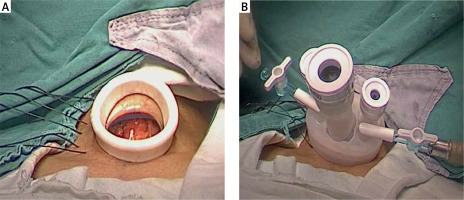
Under single-port endoscopy with carbon dioxide insufflation, the thyroid lobe is retracted medially with a laparoscopic grasper, then the plane between the thyroid and carotid artery is opened. The middle thyroid vein, if present, is divided with the ultrasonic scalpel. The superior pole is pulled inferiorly, and the avascular space between the superior pole and the cricothyroid muscle is opened to expose the branches of the superior thyroid artery and vein, which are transected as closely as possible to the gland to avoid injuring the external branch of the superior laryngeal nerve (Photo 3). Then the superior pole is freed up from its remaining attachments and mobilized inferiorly. The superior parathyroid gland is often identified clearly on the posterior aspect of the superior pole; however, if it is not seen clearly, it is unnecessary to perform further dissection provided that the dissection is kept to the thyroid capsular plane. Attention is redirected to the inferior pole. The inferior thyroid vein is divided close to the thyroid gland. The thyroid lobe is then rolled medially, and the perithyroidal tissue is carefully dissected. The recurrent laryngeal nerve is then identified, usually in the tracheoesophageal groove (Photo 4). The nerve is then traced for a distance of approximately 2 to 3 cm. The inferior parathyroid gland may be encountered and identified during the inferior pole mobilization.
Photo 4
Exposure of the recurrent laryngeal nerve (white arrow) and identification of the inferior parathyroid gland (black arrow)
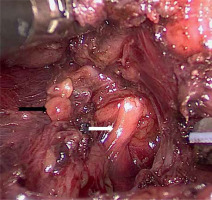
The endoscope and the valve component are removed, whereas the wound retractor component may be removed or left in place transiently, providing consistent exposure. The thyroid lobe is gradually pulled out from the wound (Photo 5). The lobectomy is then conducted as in open surgery under direct vision. After irrigation and assurance of hemostasis, A 3-mm closed suction drainage tube is placed. The strap muscles and the platysma are reapproximated, and the skin is closed with a running, absorbable, 5-0 subcuticular suture.
COT procedure
COT was performed in the supine position with the neck extended under general endotracheal anesthesia. A 4–8 cm transverse collar incision was made about 2 fingers above the suprasternal notch. After completion of thyroidectomy, the incision was closed in the same way as for HP.
Data collection
The incision length, operative time, intraoperative blood loss, postoperative drainage and hospital stay, postoperative pain, complications and cosmetic result were recorded. All patients were asked to evaluate pain 24 h after the operation. Postoperative pain was assessed by means of a visual analog scale (VAS), where 0 cm = “no pain” and 10 cm = “worst pain imaginable”. All patients were asked to grade the cosmetic appearance of the wound 2 months after surgery at the follow-up appointment or by phone. The cosmetic result was evaluated by a verbal response scale (VRS). The VRS had 4 options: 1 = poor, 2 = acceptable, 3 = good, 4 = excellent.
Statistical analysis
Continuous variables were compared using the unpaired t-test or the Mann-Whitney U test as appropriate. Categorical variables were compared using Pearson’s χ2 test or Fisher’s exact test as appropriate. SPSS 21.0 software was used. All tests of significance were two-sided, and a value of p < 0.05 was considered statistically significant.
Results
This study included 30 patients who underwent HP and 18 patients who underwent COT. There were no significant differences in the baseline clinical characteristics such as age, sex, body mass index, or maximal nodule diameter between the two groups (Table I).
Table I
Baseline clinical characteristics
The incision length of the HP group was obviously smaller than that of the COT group. There were no significant differences in operative time, intraoperative blood loss, postoperative drainage and postoperative hospital stay between the two groups. Compared with the COT group, patients in the HP group experienced less pain at 24 h after the operation as evaluated by VAS. The patients in the HP group were more satisfied with the cosmetic result as evaluated by VRS (Table II, Photo 6).
Table II
Surgical outcomes
No complications such as recurrent laryngeal nerve palsy, hypocalcemia or wound complications (surgical site infection, hematoma) occurred in the HP group. The only complication was in 1 patient in the COT group. A male patient presented with transient recurrent laryngeal nerve palsy immediately after surgery, but he recovered 2 months later. No other complications occurred in the COT group. There were no significant differences in the incidence of surgical complications between the two groups.
Discussion
In this study, clinical outcomes were compared for two patient groups: the HP and the COT group. The results showed that the patients in the HP group experienced less pain at 24 h after the operation, whereas in operative time, intraoperative blood loss, postoperative drainage and hospital stay, there was no significant difference between the two groups. This indicates that HP is a technically feasible minimally invasive procedure. Regarding the safety, there were no significant differences in the incidence of surgical complications between the two groups. Moreover, our data also illustrated the evident improvement in cosmetic results in patients who underwent HP compared with those who underwent COT. The better cosmetic results of HP can be attributed to the shorter skin incision. Sabuncuoglu et al. [18] and Govednik et al. [5] reported that shorter scar length produced significantly better cosmetic satisfaction ratings in thyroidectomy patients. A prospective cohort study showed that patients of all demographics prefer shorter scars over longer scars [19].
Among the various approaches to the minimally invasive thyroidectomy, MIVAT described by Miccoli et al. [11] is the most popular. HP is technically somewhat similar to MIVAT in that they are both hybrid techniques combining endoscopic surgery and mini-incision open surgery. The basic differences between the two procedures are mainly manifested in the following two aspects. First, the endoscopic working space is maintained by carbon dioxide insufflation in HP, whereas it is maintained by gasless mechanical retraction in MIVAT. The working space offered by the carbon dioxide insufflation technique is more expansive than that offered by the gasless technique [20, 21] and is helpful to expedite the operation. The greater working space is one of the advantages of HP over MIVAT. The risk of gas-related complications can be prevented by low insufflation pressure ≤ 6 mm Hg [22, 23]. In fact, no gas-related complications occurred in our study. Second, the single-port device is used in HP, which provides stable fulcrums for the laparoscopy and surgical instruments, whereas in MIVAT, since the endoscopy and surgical instruments are directly inserted through a small incision without stable fulcrums, inadvertent conflict between the endoscopy and surgical instruments cannot be avoided and this can impair surgical performance [14, 15]. In particular, the field of view may easily be disturbed by involuntary hand tremor of the camera assistant, who tends to become fatigued from holding a camera in the air without a fulcrum [16, 17]. Surgeons usually feel uncomfortable performing MIVAT because of unstable images during surgery. Stable images and maneuverability associated with a stable fulcrum offered by the single port device is another important advantage of HP over MIVAT. In most reports, the operative time of MIVAT was obviously longer than that of COT [7, 8]; however, the operative time of HP is not significantly prolonged compared with that of COT. This may largely contribute to the two technical advantages of HP over MIVAT.
Some concerns may be raised about the challenge imposed by single-port endoscopic surgery. The main technical obstacles of single-port endoscopic surgery are difficult triangulation formation between instruments, and external conflict between the light cable and working instrument handles [24, 25]. However, we have found that they are not major obstacles to performing HP. First, the formation of the triangulation is related to the distance between the incision and the target organ. In HP, the incision is very close to the thyroid; thus there are still adequate angles between instruments. This situation is different from that in single-port remote access endoscopic thyroidectomy, in which there are small angles between instruments due to the long distance between the incision and the thyroid. Second, external conflict between instrument handles can be minimized by application of conventional straight laparoscopic instruments of different lengths [26], which allows placement of an instrument handle on a different plane from the handle of another instrument. A laparoscope with a right-angle light cable connector attached can minimize external conflict between the light cable and working instrument handles.
Our study has some limitations. It was retrospective and not randomized. Especially, the choice of surgical approach based on the patient’s preference is a potential source of bias. The follow-up was short and the long-term effectiveness of HP in the cosmetic outcome needs to be studied further. Stronger evidence would be established by a large sample randomized prospective study with a long-term follow-up. In addition, it would be helpful to include laboratory parameters regarding stress and inflammation in the future prospective study, for they may be useful to assess the invasiveness of the surgical procedures.
Conclusions
In selected patients, the technique of minimal transcervical access single-port endoscopy-assisted thyroidectomy (Huang’s procedure, HP) is a feasible and safe alternative to COT, and is superior to COT in terms of incision length, postoperative pain and cosmetic satisfaction.
Supplementary data
Supplementary videos available at “Videosurgery and Other Miniinvasive Techniques” online.









